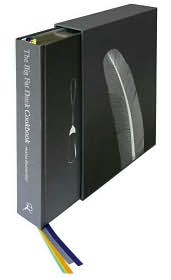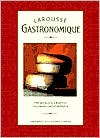My first blog. I can't be certain the thoughts rummaging about in my mind will successfully make it to the page. Or that these entries will be interesting at all. I'm pretty certain the direction of my writing will be influenced by my daily goings on in my kitchen and elsewhere, but it will most certainly be affected by you, the reader.
So it's Christmas time and I am terrible with surprise gifts. Mostly, I prefer to reveal what I want so I can give exact instruction on what to get. Many times I will go and get the gift myself. No surprises. No disappointments. Because I like to cook and I LOVE food, my friends, my family and co-workers love to gift books like The Ultimate Cookie Book or Home Cooking: The Costco Way. These books are mostly OK, but if I were suggesting a cookbook I'd select something like The Big Fat Duck Cookbook or Larousse Gastronomique.


My most recent gift request is a full-sized food processor to replace the tiny 3-cup unit on my counter top. It sits under the Christmas tree unwrapped and in plain view begging me to use it. I need the larger unit because a 3-cup processor can hardly do the job of making dough for a two-crust pie. I needed it for one thing only, to make my pie crust-making easier. For that, my new 11-cup Pro 11 Cuisinart will suit me fine.
All of you pie crust making purists may think using a food processor to make pie crust is akin to cheating, but I disagree. I've made crust purely by hand, by mixer and by processor and I've discover my highest level of comfort, consistency and success using the processor. With a 3-cup machine, my ingredients typically reach all the way to the top of the unit forcing me to complete the dough-making process in a separate bowl. This forces me to take more time to bring the dough together. Time is important because I want my dough to remain cold to keep the butter and shortening from softening and melting.
Finishing in the processor is not without risk. If I'm not careful I could overwork the dough. It will likely take me a couple of tries before I feel I know my way around finishing it this way. In the past, my best crusts have been those where the butter is still visible when I put it in the fridge to rest for an hour. Also, I tend to use a butter:shortening ratio if about 3:1. Frozen fats are best and easy to work with when using a quality processor. A word or two on lard: I like lard and I use it. For me, all butter and butter/shortening crusts are OK but don't come close to matching the all around qualities of using a bit of pig fat. What are those qualities? Easy, layers of flakiness and great flavor! Hmm, I wonder how duck fat would do...
I recently wrote on someones Facebook page that duck fat is the best thing to ever happen to French fried potatoes. Try it and I think you will agree. I digress.
This is my second go round with a large Cuisinart, the last one and I got separated during various moves, and I cook A LOT more now than I did then. The slice, dice, mix and grind tango I do with this one will be memorialized in future postings. I would like to say it'll begin AFTER Christmas but I'm not sure I can wait that long.
In the meantime, I need to go and get started on my Roasted Chicken for tonight's dinner. I'll remove the back, flatten the bird and roasted under a weight. It'll have some fresh herbs, butter and bacon and the drippings will make a glorious gravy. I have some red skinned fingerling potatoes that I will saute in olive oil and minced garlic. I think creamed corn will work as a decadent side veggie that I'll flavor with some fresh rosemary from my mini-garden.
RECIPE:
OK, I make enough pie dough for a double crust. My recipe is really a merger of my favorite recipes over the years, including the process I use to create it. Here it is:
INGREDIENTS
2 1/2 cups All Purpose Flour
1 Tsp Salt
3 Tbsp Granulated Sugar
1 1/2 Sticks Butter (12 Tablespoons)
4 Tbsp Lard/Vegetable Shortening
5 Tbsp ICE COLD water (or Vodka*)
HOW TO MAKE:
Mix 1 1/2 cups of flour, salt & sugar in food processor (pulse about 5 or 6 times for about one second per pulse). Cut butter and lard in small pieces of about a tablespoon each (careful, don't handle to much as you don't want the butter to melt) and add to the processor. Cut the fat into the flour by pulsing until the mixture becomes coarse. Most recipes say the butter should be cut to the size of peas. That works for me. Add the remaining cup of flour and pulse until mixed.
OK, at this point you have two choices; one, drizzle water into the processor while you pulse the machine. You need to know what dough should look like to do it this way because you can easily over mix it. And two, you can pour the flour mixture into a separate bowl and mix the water in with a wooden spoon or rubber spatula. Don't use your hands or you will melt the butter! Sorry about yelling. With the spatula, mix and press the dough together. If the dough is too dry it will be nearly impossible to roll (or at least very unpleasant) so feel free to add more water in increments of 1 Tbsp until you have a nice, mostly smooth, dough that is not wet or sticky. Take your time with this step and you'll be happy with the results.
Split the dough into two balls. I try to keep one ball slightly larger than the other. I'll then use the larger dough as the bottom crust which helps me to shape the pie shell better. At this point you want to flatten slightly into a disk, give it a light dusting of flour and wrap in plastic. Place in the refrigerator for one hour (or so). Before rolling, allow the dough to warm a bit to room temperature so it will roll easier. Use flour on your rolling surface but don't over do it because the flour can cause your dough to dry out.
No comments:
Post a Comment